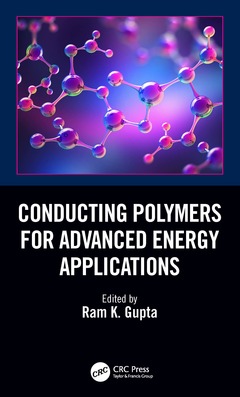Description
Conducting Polymers for Advanced Energy Applications
Language: English
Subjects for Conducting Polymers for Advanced Energy Applications:
Keywords
Conducting Polymers; metal oxides; Energy Density; chalcogenides; Solar Cell; beyond graphene; American Chemical Society; photovoltaics; PPy; fuel cells; Microbial Fuel Cells; batteries; Electrode Material; polymer nanocomposites; Organic Solar Cells; supercapacitors; PeSCs; graphene materials; SEM Image; EDLCs; CP Nanocomposites; Hole Transporting Layer; Polymer Solar Cells; Max Phase; PANI Nanofibers; Equivalent Circuit; PPy Composite; Electrochemical Performance; Emeraldine Salt; PEs; Current Collector; Go; CS
· 17.8x25.4 cm · Hardback
Description
/li>Contents
/li>Readership
/li>Biography
/li>
This book details the use of conducting polymers and their composites in supercapacitors, batteries, photovoltaics, and fuel cells, nearly covering the entire spectrum of energy area under one title. Conducting Polymers for Advanced Energy Applications covers a range of advanced materials based on conducting polymers, the fundamentals, and the chemistry behind these materials for energy applications.
FEATURES
- Covers materials, chemistry, various synthesis approaches, and the properties of conducting polymers and their composites
- Discusses commercialization and markets and elaborates on advanced applications
- Presents an overview and the advantages of using conducting polymers and their composites for advanced energy applications
- Describes a variety of nanocomposites, including metal oxides, chalcogenides, graphene, and materials beyond graphene
- Offers the fundamentals of electrochemical behavior
This book provides a new direction for scientists, researchers, and students in materials science and polymer chemistry who seek to better understand the chemistry behind conducting polymers and improve their performance for use in advanced energy applications.
1. Introduction: Conductive Polymers from the Nobel Prize to Industrial Applications 2. Materials and Chemistry of Conducting Polymers 3. Conducting Polymers for Supercapacitors 4. Supercapacitors Based on Nanocomposites of Conducting Polymers and Metal Oxides 5. Nanocomposites of Conducting Polymers and 2D Materials for Supercapacitors 6. Conducting Polymer-Based Flexible Supercapacitors 7. Nanofibers of Conducting Polymers for Energy Applications 8. Conducting Polymers for Organic Solar Cell Applications 9. Hybrid Conducting Polymers for High-Performance Solar Cells 10. Nanocomposites Based on Conducting Polymers and Metal Sulfides for Solar Cell Applications 11. Thin Films of Conducting Polymers for Photovoltaics 12. Application of 2D Materials in Conducting Polymers for High Capacity Batteries 13. Conducting Polymers in Batteries 14. The Role of Chalcogenide in Conducting Polymers for Enhanced Battery Performance 15. Conducting Polymers for Flexible Devices 16. Conducting Polymer Nanocomposites for Flexible Devices 17. Conducting Polymers for Electrocatalysts 18. Conducting Polymer-Based Microbial Fuel Cells 19. Conducting Polymers as Membrane for Fuel Cells 20. Synthesis and Characterization of Poly(zwitterionic) Structures for Energy Conversion and Storage 21. High Performance Conducting Polymer Nanocomposites for EMI Shielding Applications 22. Challenges and Future Lookout of Conductive Polymers




